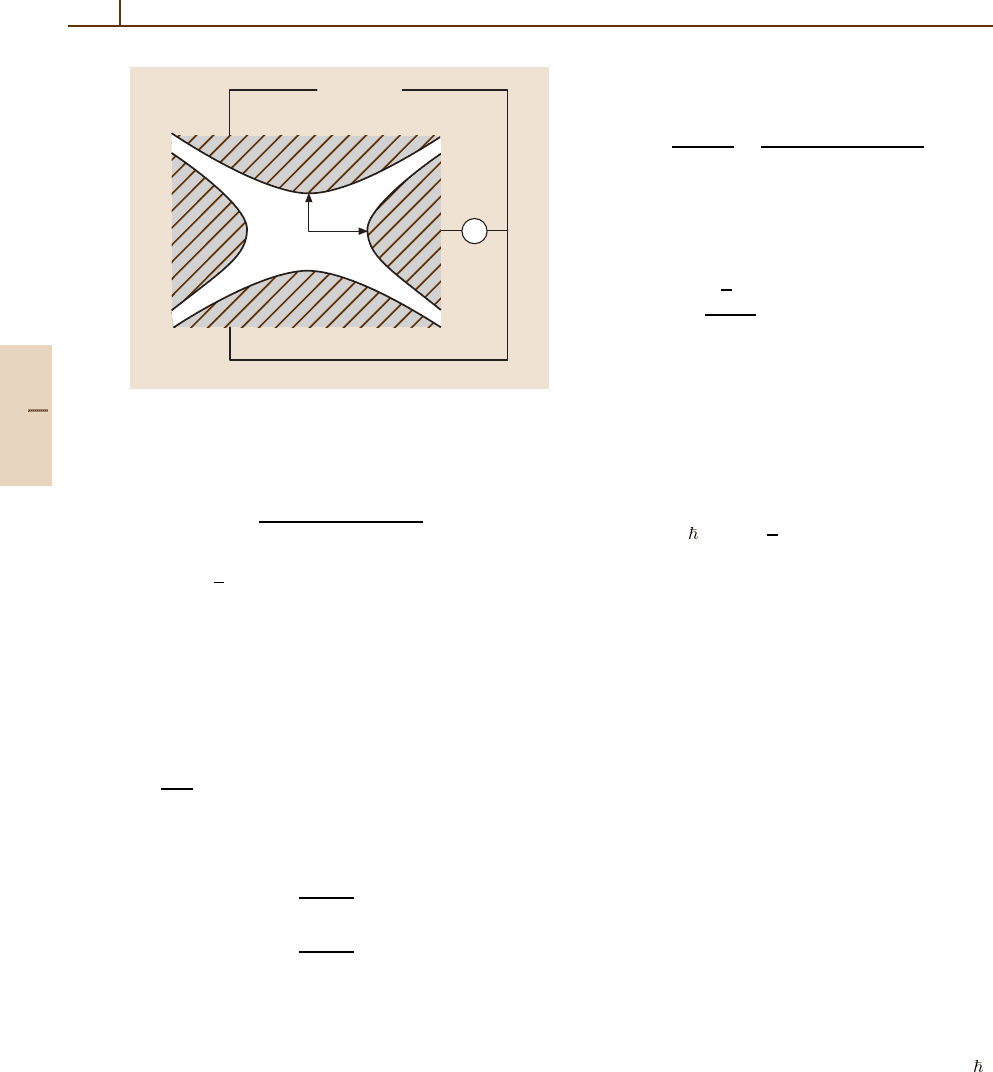Drake G.W.F. (editor) Handbook of Atomic, Molecular, and Optical Physics
Подождите немного. Документ загружается.


Cooling and Trapping 75.4 Trapping and Cooling of Charged Particles 1099
zero at x =0. Suppose that the gradient of Bis chosen in
such a way that the m = 1(m =−1) magnetic substate
of the excited state has the higher (lower) energy for
x > 0, and that the atom is illuminated by σ
±
polarized
beams propagating in the ±x-directions, tuned below
resonance. When the atom is displaced from x =0inei-
ther direction, it is closer to resonance with the beam that
pushes it back toward x = 0. This makes the restoring
force responsible for trapping.
A magneto-optical trap can be set up also in three
dimensions. A quadrupole magnetic field of the form
B(r)
∂B
z
∂z
r=0
z
ˆ
e
z
−
1
2
x
ˆ
e
x
−
1
2
y
ˆ
e
y
(75.48)
is produced by reversing the direction of current in one of
the two Helmholtz coils. Three orthogonal pairs of light
beams, each in the σ
+
–σ
−
configuration, complete the
trap. The magnetic field is sourceless. To compensate
for the ensuing signs of the field gradients, one of the
σ
+
–σ
−
corkscrews has the opposite handedness from
the other two.
The mechanism of the magneto-optical trap for the
J = 0 →1 configuration is the same as the mechanism
for Doppler cooling, except that position dependent level
shifts of the excited states take the place of velocity
dependent Doppler shifts. The restoring force and the
damping coefficient of Doppler cooling are closely re-
lated. For the coordinate directions u = x, y, z the relation
is
F
u
=−κ
u
u,κ
u
= β
mg
e
µ
B
k
∂B
u
∂u
,
(75.49)
where g
e
is the Landé factor for the excited state.
A magneto-optical trap may similarly be based on
the induced orientation mechanism of polarization gra-
dient cooling. In that case, the Landé factor of the
ground state, g
g
, should probably be used in (75.49).
This may be the true mechanism of most magneto-
optical traps, but insufficient quantitative understanding
precludes firm conclusions.
Atoms in a well-aligned magneto-optical trap reside
near the zero of B, so that the magnetic field has little
effect on polarization gradient cooling. Trapping and
cooling are achieved simultaneously.
75.3 Magnetic Trap for Atoms
The magnitude B(r) of a magnetic field may have a min-
imum in free space, as in (75.48). A particle with
a magnetic dipole moment µ then experiences a trap-
ping potential U(r) = µB(r) if µ and B are antiparallel.
µ remains locked antiparallel to B if the field seen by
the moving dipole satisfies the adiabatic condition
1
B
dB
dt
µB
(75.50)
(Section 73.3.4). However, if B(r) =0 at the minimum,
the adiabatic condition is violated and the dipole may
flip (Majorana transition). The particle may end up in
a repulsive potential, and get expelled from the trap.
This becomes a problem at low temperatures, when the
particles accumulate near the minimum of the poten-
tial. Trap configurations are therefore designed in which
B(r) = 0 at the minimum.
Evaporative Cooling.
A magnetic trap is often combined with evaporative
cooling. The most energetic atoms from the tail of the
thermal distribution escape from the trap, whereupon the
average energy of the remaining atoms decreases. Suc-
cessful operation of evaporative cooling requires a high
enough rate of elastic collisions so that the atoms ther-
malize in a time short compared with the lifetime of the
sample. In order to sustain the rate of evaporation, the
effective depth of the trap is lowered as the atoms cool.
75.4 Trapping and Cooling of Charged Particles
Since the potential Φ(r) of a static electric field satisfies
Laplace’s equation, Φ(r) cannot have an extremum in
free space. A static electric field therefore cannot serve
as an ion trap (Earnshaw’s theorem). Paul and Penning
traps circumvent this limitation by making use of an al-
ternating electric field and a magnetic field, respectively.
Cooling is often employed to assist trapping.
75.4.1 Paul Trap
Trapping
Configuration. Consider an ideal trap whose sur-
faces are hyperboloids of revolution; see Fig. 75.2.
The two “endcaps” and the intervening “ring”
are equipotential surfaces of the quasistatic electric
Part F 75.4

1100 Part F Quantum Optics
z
0
U–Vcos ω
˜
t
ρ
0
⬇
Fig. 75.2 Electrode configuration and voltages of an ideal
hyperboloid Paul trap
potential
Φ(x, y, z) =
Φ
0
(t)
2z
2
−x
2
−y
2
2
2
0
, (75.51)
where
0
is the distance from the center to the ring,
z
0
=
0
/
√
2 is the distance to the endcaps, and Φ
0
(t) is
a voltage applied between the endcaps and the ring,
Φ
0
(t) =U −V cos
˜
ωt . (75.52)
Motion of an Ion. In the ideal three-dimensional Paul
trap, Newton’s equations of motion for the coordinates
u = x, y or z may be recast as Mathieu’s equations,
d
2
u
dτ
2
+(a
u
−2q
u
cos 2τ)u = 0 , (75.53)
where τ =
˜
ωt/2 is a dimensionless quantity proportional
to time, the parameters are
a
z
=−2a
x,y
=−
8qU
m
˜
ω
2
2
0
, (75.54)
q
z
=−2q
x,y
=−
4qV
m
˜
ω
2
2
0
, (75.55)
and m and q are the mass and charge of the particle.
Stable trapping ensues when a
u
and q
u
are such that the
motion of the ion is stable in all directions. A Paul trap
normally operates in the first stability region of (75.53).
Stable motion may be qualitatively divided into
forced micromotion at the frequency
˜
ω of the external
drive, and into slower secular motion of the center of the
micromotion. If U = 0, the secular motion takes place
in an effective ponderomotive potential U
P
, Sect. 74.2,
equal to the cycle-averaged kinetic energy in the micro-
motion. Explicitly,
U
P
(r) =
q
2
E
2
(r)
4m
˜
ω
2
=
q
2
V
2
x
2
+y
2
+4z
2
4m
˜
ω
2
4
0
,
(75.56)
where E (r) is the ac field amplitude. This is an
anisotropic harmonic oscillator potential characterized
by the oscillation frequencies
ν
z
= 2ν
x,y
=
√
2qV
m
˜
ω
2
0
. (75.57)
Quantization of C.M. Motion. The separation of micro-
motion and secular motion is excellent, and the trap
is stable, when ν
x,y,z
˜
ω. Ignoring the micromotion,
the cm motion of the ions in the potential U
P
(r) may
be quantized readily. The energy of a state with n
x,y,z
quanta in the coordinate directions x, y, z is
E =
i=x,y,z
ν
i
n
i
+
1
2
.
(75.58)
Variations of Paul Trap. Little practical advantage usu-
ally arises from a realization of the ideal shape. Even
a single electrode with an applied ac voltage may work as
a Paul trap. A linear trap is basically a two-dimensional
Paul trap with an added static longitudinal potential to
prevent escape of the ions from the ends of the trap.
A closed race track Paul trap is obtained by bending
a linear trap into a ring.
Cooling
Laser Cooling in One Dimension. The secular motion
of an ion may be cooled using lasers. Consider the
motion of the ion in one of the principal-axis direc-
tions x, y, z, with ν denoting the corresponding cm
frequency. In the common case where γ ν, Doppler
cooling works basically as with a free atom. In the con-
trary case, ν γ , cooling may be achieved by tuning
the laser to ω = ω
0
−ν. Resonant photoabsorption start-
ing with n cm quanta decreases the quantum number
from n to n −1, and subsequent spontaneous emission
on the average leaves the cm energy nearly untouched.
The net effect is reduction of the cm energy by
ν
in such a Raman process. Since the oscillating ion
sees a frequency-modulated laser with sidebands, this
method of ion cooling is called sideband cooling.
For one-dimensional motion of a two-state ion in
a traveling light wave at low I, the velocity damping
Part F 75.4

Cooling and Trapping 75.4 Trapping and Cooling of Charged Particles 1101
rate is
β =
2Ω
2
γ∆
(∆ +ν)
2
+γ
2
(∆ −ν)
2
+γ
2
ε
r
, (75.59)
and the expectation value of the cm energy is
E =
4∆
∆
2
+γ
2
+ν
2
+ α
(∆ −ν)
2
+γ
2
(∆ +ν)
2
+γ
2
∆
2
+γ
2
,
(75.60)
where α characterizes the angular distribution of sponta-
neous emission, see (75.29). The result (75.60)isuseful
when either ε
r
γ or ε
r
ν. The limit ν γ is for
Doppler cooling; the temperature from (75.60) coin-
cides with (75.33)forafreeatom.Thecasewithboth
ν γ and ε
r
ν corresponds to sideband cooling in the
Lamb–Dicke regime, in which the cooled ion is confined
to a region much smaller than λ.
In connection with sideband cooling, it is convenient
to cite the expectation number of harmonic oscillator
quanta n instead of energy or temperature; the latter
are
E =
ν
n+
1
2
, T =
ν
k
B
ln
1 +n
−1
−1
.
(75.61)
For optimal sideband cooling, ν γ and ∆ =ν,the
result is
n=
1
4
(1 +4α)
γ
ν
2
+O
γ
ν
4
.
(75.62)
In principle, by decreasing the linewidth γ ,theionmay
be put arbitrarily close to the ground state of the cm har-
monic oscillator. Such a decrease is not practical in real
two-state systems, but is routinely achieved by using the
two-photon resonance in a three-state Λ configuration
as an effective two-state system; see Sect. 73.6.2.
Laser Cooling in Three Dimensions. Either by design
or chance, no two of the ν
i
are precisely degenerate. If
the damping rate β and the trap frequencies ν
i
satisfy
β
|ν
i
−ν
j
|, i = j , (75.63)
the motion of the ion in each principal axis direc-
tion of the trap is cooled independently of the other
directions. For γ ν
x,y,z
, a single laser beam propagat-
ing approximately in the direction
1/
√
3
(
ˆ
e
x
+
ˆ
e
y
+
ˆ
e
z
)
suffices to cool all components of the secular motion.
Energy in Micromotion. Possibly with the aid of com-
pensating static electric fields, one cooled ion may be
confined near the zero of the trapping ac electric fields.
Then the energy in the micromotion is comparable to
the energy in the secular motion.
75.4.2 Penning Trap
Trapping
Configuration. In the Penning trap, a dc voltage U is
applied between the endcaps and the ring, and a constant
magnetic field B in the direction of the trap axis z is
added. The magnetic field forces an ion escaping toward
theringtoturnback.
Motion of an Ion. The motion of an ion is a super-
position of three periodic components. For the same
ideal hyperboloid shape that was discussed with the Paul
trap, (75.51) and Fig. 75.2, the three components are
completely decoupled. Firstly, in the axial direction, the
ion executes oscillations at the axial frequency
ν
z
=
2qU
m
2
0
1/2
. (75.64)
Secondly, the ion undergoes cyclotron motion in the
plane perpendicular to the trap axis. As a result of the
electric field, the frequency of the cyclotron motion
ν
c
=
1
2
ν
c
+
1
4
ν
2
c
−
1
2
ν
2
z
1/2
(75.65)
is displaced from the cyclotron frequency ν
c
= qB/m
of a free ion. Thirdly, the guiding center of cyclotron
motion rotates about the trap axis at the magnetron
frequency
ν
m
=
1
2
ν
c
−
1
4
ν
2
c
−
1
2
ν
2
z
1/2
. (75.66)
The frequencies typically satisfy
ν
m
ν
z
ν
c
. (75.67)
Magnetron motion has unusual properties. It takes up
the majority of the electrostatic energy in the transverse
directions, which in the absence of the magnetic field
would lead to expulsion of the ion. Relative to a station-
ary ion at the trap center, the energy of the magnetron
motion is bounded from above by zero. The radius, as
well as velocity and kinetic energy of magnetron mo-
tion, decreases with increasing total energy. The energy
for a state with n
c
, n
z
and n
m
quanta in the cyclotron,
Part F 75.4

1102 Part F Quantum Optics
axial and magnetron motions is therefore
E =
ν
c
n
c
+
1
2
+
ν
z
n
z
+
1
2
−
ν
m
n
m
+
1
2
.
(75.68)
Cooling
Laser Cooling. For ions in a practical Penning trap, the
frequencies ν
c
, ν
z
and ν
m
are <γ.Ifk is not orth-
ogonal to either the cyclotron motion or the axial motion,
Doppler cooling proceeds essentially as for a free atom.
However, energy should be added to the magnetron mo-
tion in order to reduce the magnetron radius and velocity.
The solution is to aim a finite-size laser beam off the
center of the trap in such a way that an ion experiences
a higher (lower) intensity over the part of its magnetron
orbit in which it travels in the direction of (opposite
to) the laser beam. With a proper choice of the param-
eters, the ensuing addition of energy overcomes Doppler
cooling of the magnetron motion.
Other Cooling Methods. Precision measurements are
carried out in Penning traps with objects that do not have
an internal level structure suitable for laser cooling; and
thus, other cooling methods are used.
For light particles such as electrons, characteristic
times of radiative damping of the cyclotron motion are
in the subsecond regime, and hence, so are the equi-
libration times with blackbody radiation. Cooling is
accomplished by enclosing the trap in a low-temperature
(e.g. liquid helium) environment. For protons and heav-
ier particles, the equilibration times of the cyclotron
motion with the environment are impracticably long,
and the same applies to the axial and magnetron motions
even for electrons.
A workable cooling scheme for the axial motion is
based on the charges that the oscillating particle induces
on the endcaps. The charges generate currents in an
external circuit connecting the endcaps. The endcaps
are thus coupled to a cooled resonant circuit tuned to
the axial frequency, and axial motion relaxes to thermal
equilibrium with the resonant circuit. A variant of this
resistive cooling , in which the ring is split into elec-
trically insulated segments, is used to cool the cyclotron
motion of protons and heavier ions.
Magnetron motion of an electron or proton is cooled
by sideband cooling. An electric field with compon-
ents in both the z-direction and xy-plane, and tuned
to ω = ν
z
+ν
m
, drives transitions which may either in-
crease or decrease the number of quanta in each mode.
However, the matrix elements favor transitions with
∆n
z
= 1and∆n
m
=−1. Pumping of the axial motion
is canceled by axial cooling, while an equilibrium with
low kinetic energy ensues for the magnetron motion.
Ideally, the ratio of kinetic energies becomes
T
kin,m
T
kin,z
=
ν
m
ν
z
. (75.69)
75.4.3 Collective Effects in Ion Clouds
As soon as there is more than one ion in the trap,
Coulomb interactions between the ions profoundly
shape the physics [75.15, 16].
Ion Crystal
In the standard Paul trap radio frequency heating due
(presumably) to transfer of energy from micromotion
to secular motion limits the number of ions that can
be cooled efficiently by a laser. Nevertheless, at a low
temperature, the ions settle to equilibrium positions cor-
responding to a minimum of the joint trapping and
Coulomb potentials, and form a “crystal”. Depend-
ing on the trap parameters, the ions may also execute
quasiperiodic or chaotic collective motion, or move
nearly independently of one another. Changes between
crystalline and liquid forms of the ion cloud resembling
phase transitions are observed.
Strongly Coupled Plasma
Cooling of a large number of ions is possible in a Pen-
ning trap. However, magnetron motion becomes uniform
rotation of the entire cloud, and Coulomb interactions
set a lower limit on the attainable radius of the cloud.
This leads to a lower limit on the kinetic energy and
second-order Doppler shift.
In a co-rotating frame, the ions behave like a one-
component plasma on a neutralizing background. The
characteristic parameter for a one-component plasma
with charge per particle q and density n is
Γ
P
=
4πn
3
1/3
q
2
4π
0
k
B
T
,
(75.70)
essentially the ratio of the Coulomb energy between two
nearest-neighbor ions divided by the thermal kinetic en-
ergy. Γ
P
> 1 indicates a strongly coupled plasma; for
Γ
P
> 2andΓ
P
> 170 solid and liquid phases are ex-
pected in an infinite plasma. Experiments with a Penning
trap have produced Γ
P
300. Concentric shells of ions
or various more or less crystalline arrangements are seen
depending on the experimental conditions.
Part F 75.4

Cooling and Trapping 75.5 Applications of Cooling and Trapping 1103
Sympathetic Cooling
In a trap that holds two or more species of charged
particles, cooling of the motion of one species is trans-
ferred by Coulomb interactions to the other species. This
sympathetic cooling broadens the scope of ion cooling
methods.
75.5 Applications of Cooling and Trapping
Trapping and cooling offer increased interaction times
between the atoms/ions and the light. This leads
to reduced transit time broadening, and indeed to
macroscopic (> 1 s) interaction times. Laser cooling in
a magneto-optical trap routinely gives temperatures so
low that the Doppler width is below the natural linewidth
of the cooling transition. A homogeneously broadened
atomic sample is thus prepared. Cooling also enables
reduction of the second-order Doppler effect.
Various frequency measurements are the prime ben-
eficiary of cooling and trapping. Potential applications
range from detection of the change of natural constants
in time Chapt. 30 to such feats of technology as the
Global Positioning System.
75.5.1 Neutral Atoms
Experimental Considerations
Originally the experiments often started with a longi-
tudinal deceleration and cooling of an atomic beam by
a counterpropagating laser beam. To compensate for the
change of the Doppler shift of the atoms while they
slowed down, the position dependent magnetic field of
a tapered solenoid shifted the transition frequency of the
atoms to keep them near resonance while they moved
down the solenoid. A magneto-optical trap then scooped
some atoms, cooled them further, and captured them.
Nowadays this Zeeman slower ist mostly supplanted
by various schemes in which a MOT directly captures
atoms from the low-velocity wing of the thermal dis-
tribution. Depths of neutral-atom traps are below 1 K.
Storage times are typically of the order of 1 s, limited at
high densities by exothermal binary collisions and at low
densities by collisions with the atoms in the background
gas.
The temperature of cooled atoms may be measured
by the time-of-flight method. All cooling and trapping
fields are turned off, whereupon the atoms fall freely
under gravity. The distribution of arrival times of atoms
at a probe laser beam underneath the initial molasses is
compared with a numerical model for the disintegration
of the molasses. A fit gives the temperature.
The focus is on Li, Rb and Cs, to a large extent
because the required laser frequencies can be generated
using inexpensive diode lasers. Hyperfine structure of
the ground state of the alkalis complicates experiments
because the atoms may end up in an inert hyperfine
level outside the active cooling/trapping transitions. To
counteract this, a second appropriately tuned repump
laser is added to return such atoms to circulation. A few
experiments use lanthanide atoms or metastable states
of rare-gas atoms, some isotopes of which do not have
hyperfine structure.
Cold Collisions
In the molecular picture of a collision involving a laser,
optical excitation takes place at the interatomic dis-
tance for which the difference between the potential
curves of the incoming and excited states equals the
energy of a laser photon [75.17]. The end products of
an inelastic collision (fine or hyperfine structure chang-
ing collision, associative ionization, radiative escape,
etc.) are normally determined at shorter interatomic dis-
tances, when the potential curve of the excited state has
an anti-crossing with the potential curve of the product
channel. The novel feature of ultracold collisions is the
long duration due to the low velocity of the collision
partners. Spontaneous emissions and other phenomena
irrelevant at room temperature may take place during
the collision.
On the scale of typical resonance widths, at very
low temperatures the collision partners are in effect
in a single continuum state with zero energy. This fa-
cilitates photoassociation spectroscopy. Laser-induced
transitions from the initial continuum state to bound
vibrational states of the molecule are observed.
Collisions are of practical importance in that they
limit the achievable atom density in a trap: an inelastic
collision may release more kinetic energy than the trap
can contain, which results in a loss of an atom (or two
atoms) from the trap. Collision rates are actually meas-
ured by monitoring the loss rate of atoms as a function
of density. Precise energies of the molecular vibrational
states from photoassociation spectroscopy are used as
input to determine [75.18] s-wave scattering lengths
for atoms and to measure molecular parameters to an
accuracy that far exceeds the capabilities of ab-initio
calculations.
Part F 75.5

1104 Part F Quantum Optics
Frequency Standards
An atomic fountain starts with an optical molasses or
a magneto-optical trap. The laser beams are then manip-
ulated to give an upward push to the atoms. The atoms
fly up against gravity for a few tens of centimeters, then
turn back and, because of the initial transverse veloci-
ties, fan out to a “fountain”. In a fountain clock [75.19],
the fountain erupts through a microwave cavity that
drives a hyperfine transition in the atoms. The clock
is in effect an accurate measurement of the transition
frequency. The fountain is beneficial because the inter-
rogation times ≈1 s are longer and the atomic velocities
≈ 1m/s slower than in traditional beam clocks.
Bose–Einstein Condensate
At present, the most prominent basic-physics applica-
tions of cooling and trapping of atoms undoubtedly are
in studies of Bose–Einstein condensation and quantum
degenerate Fermi gases in dilute atomic vapors. This
topic is covered in Chapt. 76.
75.5.2 Trapped Particles
Experimental Considerations
Both Paul and Penning traps behave like a conserva-
tive potential, and scatter rather than confine a particle
coming from the outside. One method to load a trap is
to generate the ions in situ, e.g., by letting a beam of
atoms and electrons collide inside the trap. Time depen-
dent electric potentials are another loading method. The
trapped species is injected thorough a hole in the endcap,
and the opposing endcap is raised to an electric potential
that makes the entering particles stop. The potential is
then lowered before it ejects the particles. A single elec-
tron, positron, proton, antiproton or ion may be loaded.
Typical depths of ion traps are ≈1eVor≈ 10
4
K. With
the aid of cooling, the storage time may be made infinite
for all practical purposes.
Trap frequencies are measured by observing the res-
onance excited by added ac fields. For instance, an
electric field near the axial cm resonance frequency may
be coupled between the ring and one endcap. A reso-
nance circuit coupled between the ring and the other
endcap is used to detect the resonance. Alternatively,
ejection of the driven ions is monitored.
For an electron in a Penning trap, the cyclotron fre-
quency is in the extreme microwave region. Detection
of the resonance is achieved indirectly. The uniform
magnetic field is perturbed with a piece of a ferro-
magnet to make a magnetic bottle. The axial motion
and the cyclotron motion are then coupled. A resonant
microwave drive adds energy to the cyclotron motion,
which detectably alters the axial frequency.
The three trap frequencies satisfy
ν
2
c
= ν
2
c
+ν
2
m
+ν
2
z
. (75.71)
This relation remains valid even if the magnetic field
is misaligned with respect to the trap axis, and is also
insensitive to small imperfections in the cylindrical sym-
metry of the electrodes. The bare cyclotron frequency
may therefore be deduced accurately.
For an ion with a dipole-allowed resonance transi-
tion, fluorescence of a single ion is readily detected.
Even absorption of a single ion may be measurable.
Various methods of finding the temperature have been
devised. At temperatures of 1 K and higher, Doppler
broadening of a dipole-allowed optical transition is ob-
servable. The size of the single-ion cloud is a measure
of temperature. Finally, motional sidebands in the ab-
sorption of a narrow transition (γ ν), not necessarily
the same transition as the one used for cooling, may be
measured to find n. In the Lamb–Dicke regime only
the carrier absorption at ∆ = 0 and sidebands at ∆ =±ν
are significant, and the ratios of the peak absorptions
are
α
−
: α
0
: α
+
=n
ε
r
ν
: 1 :
(
1 +n
)
ε
r
ν
.
(75.72)
In an ion crystal, the ions have collective vibration modes
akin to phonons, instead of the three vibration modes
along the principal axes of the trap of a single ion.
Doppler cooling and sideband cooling work for such
collective modes much like they work for the vibration
modes of a single ion.
Quantum Jumps
Ion traps make it possible to isolate an individual atomic
scale particle for studies for a practically indefinite
time, which enables clean experiments on various fun-
damental aspects of quantum mechanics and quantum
electrodynamics. Quantum jumps are a case in point.
Suppose that, in addition to an optically driven two-
level system, a single ion has a third shelving state. The
ion infrequently makes a transition to the shelving state,
stays there for a long time compared with the time scale
of spontaneous emission of the active system, and then
returns to the two-level system. When the ion makes
a transition to the shelving state, fluorescence from the
two-level system suddenly ceases; and the fluorescence
reappears, equally abruptly, when the ion returns to the
two-level system. The jumps in light scattering are the
quantum jumps [75.20]. They are a method to detect
Part F 75.5

Cooling and Trapping References 1105
a weak transition with an enormous amplification: a sin-
gle transition to or from the shelving state may mean the
difference between the presence or absence of billions
of fluorescence photons.
g− 2 Measurements
For an electron, the cyclotron frequency ν
c
and the spin-
flip frequency ν
s
are related by
ν
s
=
1
2
gν
c
. (75.73)
Due to quantum electrodynamic corrections g = 2,
and so the anomaly frequency ν
a
= ν
c
−ν
s
∼ 10
−3
ν
c
is nonzero. A magnetic field at the anomaly fre-
quency causes a simultaneous flip of the spin and
a loss or gain of one quantum of energy in the
cyclotron motion. In a magnetic bottle, the change
in the cyclotron motion causes a change in the axial
resonance frequency, which is detected. The anomaly
frequency can thus be measured accurately. Together
with a measurement of the cyclotron frequency, this
yields a measurement of the g-factor of the electron,
or positron [75.21].
Measurements of Mass Ratios
As the cyclotron frequency is inversely proportional to
the mass of the ion (or electron, positron, proton, anti-
proton, etc.), an accurate measurement of the cyclotron
frequencies of two species in the same Penning trap
amounts to an accurate measurement of the ratio of
the masses [75.22]. A sufficient resolution to weigh
molecular bonds is conceivable.
Quantum System of Motional States
A vibrational mode in a trapped ion and an effective two-
state system for the internal degrees of freedom make
a realization of the Jaynes–Cummings model (discussed
in detail in Sect. 79.5.1). Moreover, sideband cooling
enables an experimenter to put this mode cleanly in its
lowest quantum state. These observations have inspired
quantum-state engineering with the objective of gen-
erating an arbitrary state of the vibrational motion of
the ion [75.23]. In many-ion crystals the collective vi-
bration modes may be used to couple and entangle the
internal degrees of freedom of two or more ions. As dis-
cussedinChapt.81, prototype quantum gates have been
demonstrated in this manner.
More generally, experiments have come to the point
when it is possible to address joint quantum states for
the internal and cm degrees of freedom almost at will.
This facilitates new cooling schemes. Time evolution
derived from a Hamiltonian can never lead to cooling;
an irreversible mechanism such as spontaneous emission
is always needed. The idea of many cooling schemes
therefore is to pump atoms optically around the quantum
states in such a way there is no pathway out of the target
state, so that the atoms eventually accumulate there.
Velocity selective coherent population trapping [75.24],
Raman sideband cooling of an ion, and Raman cooling
of an atom in an optical lattice [75.25] work in this way.
References
75.1 The Mechanical Effects of Light, J. Opt. Soc. Am. B
2(11) (1985), special issue
75.2 S. Stenholm: Rev. Mod. Phys. 58, 699 (1986)
75.3 Laser Cooling and Trapping of Atoms, J. Opt. Soc.
Am. B 6(11) (1989), special issue
75.4 C. Cohen-Tannoudji: Fundamental Systems in
Quantum Optics, ed. by J. Dalibard, J. M. Raymond,
J. Zinn-Justin (Elsevier, Amsterdam 1991) p. 1
75.5 D. J. Wineland, W. M. Itano, R. S. Van Dyck Jr.: Adv.
At.Mol.Phys.19,135(1984)
75.6 L. S. Brown, G. Gabrielse: Rev. Mod. Phys. 58,233
(1986)
75.7 Physics of Trapped Ions, J. Opt. Soc. Am. B 20(5)
(2003), special issue
75.8 Laser Cooling of Matter, J. Phys. B 36(3) (2003),
special issue
75.9 J. Javanainen: Phys. Rev. A 46, 5819 (1992)
75.10 Y. Castin, K. Mølmer: Phys. Rev. Lett. 74, 3772 (1995)
75.11 M. R. Doery, E. J. D. Vredenbregt, T. Bergeman:
Phys. Rev. A 51, 4881 (1995)
75.12 A. C. Doherty, T. W. Lynn, C. J. Hood, H. J. Kimble:
Phys. Rev. A 63, 013401 (2001)
75.13 J. Dalibard, C. Cohen-Tannoudji: J. Opt. Soc. Am. B
6, 2023 (1989)
75.14 C. Gerz, T. W. Hodapp, P. Jessen, K. M. Jones,
C. I. Westbrook, K. Mølmer: Europhys. Lett. 21, 661
(1993)
75.15 H. Walther: Adv. At. Mol. Opt. Phys. 31, 137 (1993)
75.16 J. J. Bollinger, D. J. Wineland, D. H. E. Dubin: Phys.
Plasmas 1, 1403 (1994)
75.17 P. S. Julienne, A. M. Smith, K. Burnett: Adv. At. Mol.
Opt. Phys. 30, 141 (1993)
Part F 75

1106 Part F Quantum Optics
75.18 E. G. M. van Kempen, S. J. J. M. F. Kokkelmans,
D. J. Heinzen, B. J. Verhaar: Phys. Rev. Lett. 88,
093201 (2002)
75.19 Y. Sortais, S. Bize, M. Abgrall, S. Zhang, C. Nicolas,
C. Mandache, R. Lemonde, P. Laurent, G. Santarelli,
P. Petit, A. Clairon, A. Mann, S. Chang, C. Salomon:
Phys. Scr. T95, 50 (2001)
75.20 R. Blatt, P. Zoller: Eur. J. Phys. 9, 250 (1988)
75.21 R. S. Van Dyck Jr., P. B. Schwinberg, H. G. Dehmelt:
Phys. Rev. Lett. 59, 26 (1987)
75.22 M. P. Bradley, J. V. Porto, S. Rainville, J. K. Thomp-
son, D. E. Pritchard: Phys. Rev. Lett. 83, 4510 (1999)
75.23 D. Leibfried, R. Blatt, C. Monroe, D. Wineland: Rev.
Mod. Phys. 75, 281 (2003)
75.24 J. Lawall, F. Bardou, B. Saubamea, K. Shimizu,
M. Leduc, A. Aspect, C. Cohen-Tannoudji: Phys.
Rev. Lett. 73, 1915 (1994)
75.25 S. P. Hamann, D. L. Haycock, G. Klose, P. H. Pax,
I. H. Deutsch, P. S. Jessen: Phys. Rev. Lett. 80, 4149
(1998)
Part F 75

1107
Quantum Dege
76. Quantum Degenerate Gases
The purpose of this Chapter is to summarize the
basic physics of dilute quantum degenerate gases.
Given the broad activity in the field, many choices
have to be made regarding the topics to include
and the style of the discussion. Emphasis is placed
on AMO physics, as opposed to condensed matter
physics. One related choice is that virtually nothing
is said about temperature dependence. Inside AMO
physics the approach is in the vein of quantum
optics, as opposed to atomic/molecular structure
and collisions. For the most part, the coverage is
on elementary concepts and basic material. The
exception to this is Sect. 76.5, where a few topical
issues are addressed.
The review article [76.1]hasbecomethe
standard reference on the basic properties of
a Bose–Einstein condensate (BEC), [76.2]isits
contemporary with more of a quantum optics
slant, [76.3] concentrates on conceptual is-
sues, [76.4] makes connections between the
present theories and traditional condensed mat-
ter physics, and [76.5] is particularly explicit
about the structure and excitations of a BEC. Here,
references are usually not given for topics that
are discussed in these reviews, or where a full
discussion is easily traced from them. Otherwise,
76.1 Elements of Quantum Field Theory ........1107
76.1.1 Bosons.....................................1108
76.1.2 Fermions..................................1109
76.1.3 Bosons versus Fermions .............1109
76.2 Basic Properties of Degenerate Gases ....1110
76.2.1 Bosons.....................................1110
76.2.2 Meaning of Macroscopic Wave
Function .................................. 1114
76.2.3 Fermions.................................. 1115
76.3 Experimental ......................................1115
76.3.1 Preparing a BEC.........................1115
76.3.2 Preparing a Degenerate Fermi
Gas.......................................... 1117
76.3.3 Monitoring Degenerate Gases .....1117
76.4 BEC Superfluid .....................................1117
76.4.1 Vortices.................................... 1117
76.4.2 Superfluidity ............................1118
76.5 Current Active Topics ............................1119
76.5.1 Atom–Molecule Systems............. 1119
76.5.2 Optical Lattice with a BEC ...........1121
References .................................................. 1123
references are meant to be entries to the literature
only. Assignment of credit or priority is never
implied.
Bose–Einstein condensation in dilute alkali metal va-
pors has realized a source of atoms with properties
analogous to the properties of laser light, and more
recently, ultralow-temperature Fermi gases have come
under study. The field of quantum degenerate gases
has become a main theme in AMO physics. Dilute-
vapor systems are weakly interacting, and subject to
a degree of experimental control not seen before in
traditional low-temperature condensed matter systems.
Ultralow-temperature gases have thereby also given
a new lease on life to investigations of superfluid sys-
tems in condensed matter physics. The result is a broad
interdisciplinary effort that is still expanding at the time
of writing.
76.1 Elements of Quantum Field Theory
A Bose–Einstein condensate and a degenerate Fermi gas
are both consequences of particle statistics, exchange
symmetries of the many-particle wave function. It is
possible, in principle, to deal directly with the wave
functions, but in practice analyses of many-body sys-
tems are usually carried out using the methods of second
quantization and field theory. In first quantization, the
particles are labeled as if each one had a unique tag
Part F 76

1108 Part F Quantum Optics
on it, and the wave function for more than one indis-
tinguishable particle must be symmetrized explicitly. In
second quantization, the question is how many particles
are in a given state without a distinction between iden-
tical particles. The exchange symmetries are then taken
care of automatically. Here we briefly summarize [76.6]
elementary features of quantum field theories for both
bosons and fermions.
76.1.1 Bosons
Particles with an integer value of the angular momen-
tum obey the Bose–Einstein statistics. The characteristic
property is that a one-particle state can accommodate an
arbitrary number of bosons.
State Space for Bosons. Specifically, first consider one
particle whose states are completely specified by a set
of quantum numbers k. As a notational device for the
purposes of the present Chapter, all of the quantum num-
bers are assumedly mapped in a one-to-one fashion to
nonnegative integers, and correspondingly the quantum
numbers are written k =0, 1, 2,.... The quantum num-
bers written here always incorporate a description of the
state of the c.m. motion of the particle. We therefore
have an orthonormal basis of wave functions to repre-
sent any state of a particle, {u
k
(x)}
k
,wherex stands for
the c.m. coordinate.
Given the one-particle states, the postulate is that the
Fock states |n
0
, n
1
,... ,n
∞
with n
k
= 0, 1, 2,... par-
ticles in the states k = 0, 1, 2,... form an orthonormal
basis for the many-body system.
Second-Quantized Operators for Bosons. The annihi-
lation operator for the state k, a
k
,isdefinedby
a
k
|n
0
, n
1
,... ,n
k
,... ,n
∞
=
√
n
k
|n
0
, n
1
,... ,n
k
−1,... ,n
∞
. (76.1)
Its Hermitian conjugate, the creation operator, behaves
as
a
†
k
|... ,n
k
,...=
n
k
+1 |... ,n
k
+1,....
(76.2)
It follows that
a
†
k
a
k
|... ,n
k
,...=n
k
|... ,n
k
,..., (76.3)
and so
ˆ
n
k
= a
†
k
a
k
is called the number operator for the
state k. Correspondingly,
ˆ
N =
k
a
†
k
a
k
(76.4)
is the operator for the total number of particles in the
system. The annihilation and the creation operators have
the usual boson commutators,
[a
k
, a
k
]=
a
†
k
, a
†
k
= 0,
a
k
, a
†
k
= δ
kk
. (76.5)
The boson field operator is defined as
ˆ
ψ(x) =
k
u
k
(x)a
k
. (76.6)
The commutator for the field operator,
ˆ
ψ(x),
ˆ
ψ
†
(x
)
= δ(x−x
), (76.7)
follows from boson commutators and the completeness
of the wave functions {u
k
(x)}
k
. The orthogonality of the
wave functions gives the expression
ˆ
N =
d
3
x
ˆ
ψ
†
(x)
ˆ
ψ(x) (76.8)
for the particle number operator. The positive operator
ˆ
n(x) =
ˆ
ψ
†
(x)
ˆ
ψ(x) (76.9)
evidently represents the density of the particles at the
position x.
The second-quantized operators introduced thus far
can be used to express all observables acting on indis-
tinguishable bosons. The most relevant here are the one-
and two-particle operators. One-particle operators, such
as the kinetic energy, act on one particle at a time, while
two-particle operators, such as atom–atom interactions,
refer to two particles. In first quantization, these are of
the form
O
1
=
n
V(x
n
), O
2
=
1
2
n,n
u(x
n
, x
n
),
(76.10)
where the sums run over the labels of the particles. The
corresponding second-quantized operators are
ˆ
O
1
=
d
3
x
ˆ
ψ
†
(x)V(x)
ˆ
ψ(x), (76.11)
ˆ
O
2
=
1
2
d
3
x d
3
x
ˆ
ψ
†
(x)
ˆ
ψ
†
(x
)
× u(x, x
)
ˆ
ψ(x
)
ˆ
ψ(x). (76.12)
When the particles have internal degrees of freedom
in addition to the c.m. motion, such as hyperfine and
Zeeman states, it is convenient for the present purposes
to regard particles in each internal state as a separate
species. Thus, if the quantum number breaks up into
Part F 76.1
